During his eleven years in New France (1664–75), the Jesuit priest and illustrator of seventeenth century Canada Louis Nicolas (1634–post 1700) travelled from the western end of Lake Superior to Sept-Îles (at the eastern end of New France), and from Trois-Rivières to the Iroquois lands south of Lake Ontario, his trips interspersed by numerous visits to Quebec. All of these trips were made at the behest of his Jesuit superiors, but he seems to have initiated at least one himself to a place he called “Virginia,” south of Lake Erie.
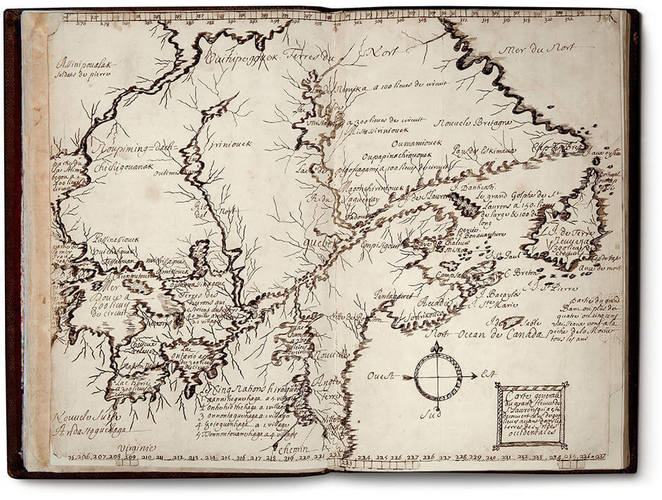
Louis Nicolas, Map, Codex Canadensis, n.d.
Ink on paper, 33.7 x 43.2, Gilcrease Museum, Tulsa, Oklahoma. The map depicts the “Manitounie,” the Mississippi River region.
The Jesuits had arrived in New France in 1611 with the goal of converting the Indigenous peoples to Christianity, and Nicolas’s first mission was to Chequamegon Bay, an isolated post situated on the southwest bank of Lake Superior. On August 4, 1667, Father Claude Allouez had returned to Sillery from the Saint-Esprit Mission in Chequamegon to recruit some “worthy men” as well as a missionary with facility in Algonquin. Nicolas was chosen as the man to go. Their journey was arduous: Marie de l’Incarnation, the founder of the Ursuline Order of nuns in Canada, reported that the Indigenous guides were overloaded and, when they reached Montreal, they threw the priests’ baggage onto the shore.
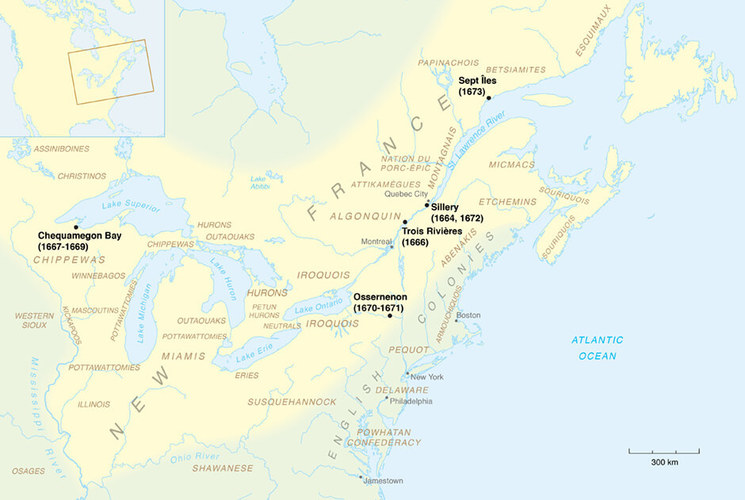
A map showing the range of Louis Nicolas’s missions.
Allouez left Nicolas in charge of the mission at Chequamegon and continued on alone up the Baie des Puants (Green Bay) on Lake Michigan, where he founded the Saint-François-Xavier Mission. Chequamegon was in Outaouaks (Ottawa) territory, part of the larger Northern Algonquin lands, and, as a centre for trade in the region, it afforded the opportunity for contact with people from many surrounding groups. As such, it was an ideal location for a mission—and, as it turned out, for the documentary artist (Nicolas’s King of the Great Nation of the Nadouessiouek, Portrait of a Famous One-eyed Man [Portrait d’un Illustre borgne], and Fishing by the Passinassiouek [La pesche des Sauvages], all n.d., illustrate some of the Indigenous leaders he met there as well as some of the customs and implements he observed). He also travelled widely from this base: his major work, the Codex Canadensis, includes drawings of Illinois and Sioux chiefs, a Mascouten man, and an Amikouek man, all of whom he would have encountered in a large area around Lake Huron and extending north.
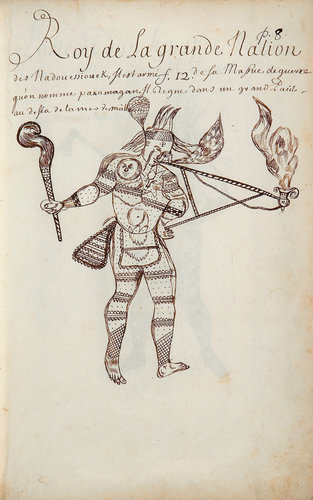
Louis Nicolas, King of the Great Nation of the Nadouessiouek (Roy de La grande Nation des Nadouessiouek), Codex Canadensis, page 8, n.d.
Ink on paper, 33.7 x 21.6 cm, Gilcrease Museum, Tulsa, Oklahoma
Within the year, Nicolas returned to Quebec, possibly sent back because of his bad temper and vanity. Antoine Alet, secretary of Gabriel de Queylus, Superior of the Sulpicians of Montreal (an order of priests engaged mainly in parish work), said the Algonquin chief Kinonché had complained that Nicolas had beaten him with a stick—even though he was the leader of a nation. Nicolas had also boasted that, when he arrived in Montreal, he would celebrate mass dressed in magnificent gold and silver garments, proving to the people how well respected he was. When the Sulpicians learned about these boasts from Kinonché himself, they refused to allow Nicolas to celebrate high mass.
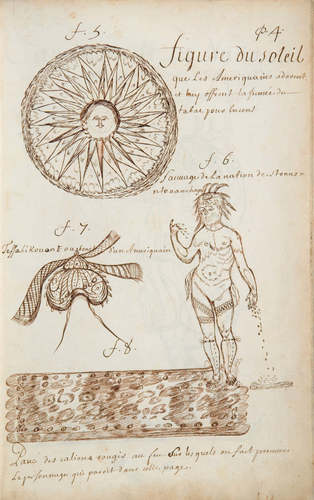
Louis Nicolas, Drawing of the Sun (Figure du soleil), Codex Canadensis, page 4, n.d.
Ink on paper, 33.7 x 21.6 cm, Gilcrease Museum, Tulsa, Oklahoma
Although Nicolas possessed a genuine passion for missionary work, his avid interest in natural history and travel, along with his rude manners, eventually made it impossible for him to meet the standards demanded by his Jesuit superiors. In 1675 he was sent back to France. The final mark against him may possibly have been that he kept two captured bear cubs in the grounds of the Jesuit residence in Sillery and trained them to do tricks, with the idea of bringing them back to France and presenting these “curiosities” to King Louis XIV himself.
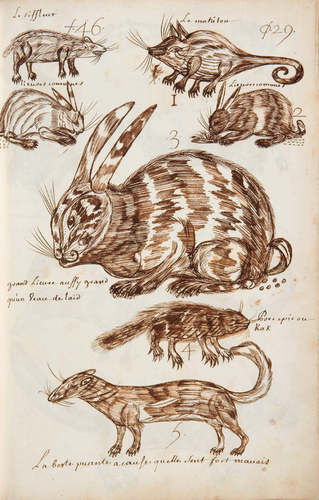
Louis Nicolas, The Whistler (Le siffleur), Codex Canadensis, page 29, n.d.
Ink on paper, 33.7 x 21.6 cm, Gilcrease Museum, Tulsa, Oklahoma
This Essay is excerpted from Louis Nicolas: Life & Work by François-Marc Gagnon.
 Karen Tam’s Autumn Tigers
Bridging Past and Present: Invisible Made Visible
By Imogene L. Lim, PhD
Karen Tam’s Autumn Tigers
Bridging Past and Present: Invisible Made Visible
By Imogene L. Lim, PhD
 The Frontier Portraits of C.D. Hoy
A Chinese Canadian Photographer’s Tribute to His Community
By Faith Moosang
The Frontier Portraits of C.D. Hoy
A Chinese Canadian Photographer’s Tribute to His Community
By Faith Moosang
 Interrogating Identity
Suzy Lake explores the role of photography in shaping how we understand and see ourselves
By Erin Silver
Interrogating Identity
Suzy Lake explores the role of photography in shaping how we understand and see ourselves
By Erin Silver
 An Emboldened Artist
How Oviloo Tunnillie achieved rare international acclaim as an Inuit female sculptor
By Darlene Coward Wight
An Emboldened Artist
How Oviloo Tunnillie achieved rare international acclaim as an Inuit female sculptor
By Darlene Coward Wight
 Painting the Cultural Mosaic
William Kurelek traversed the country in a quest to capture its diverse inhabitants
By Andrew Kear
Painting the Cultural Mosaic
William Kurelek traversed the country in a quest to capture its diverse inhabitants
By Andrew Kear
 Domestic Discontent
Mary Pratt’s poetic scenes of home life are praised for their political edge
By Ray Cronin
Domestic Discontent
Mary Pratt’s poetic scenes of home life are praised for their political edge
By Ray Cronin
 A New Vision of the North
Annie Pootoogook’s art offers unprecedented insights into the contemporary Arctic
By Nancy G. Campbell
A New Vision of the North
Annie Pootoogook’s art offers unprecedented insights into the contemporary Arctic
By Nancy G. Campbell
 Meetings of Minds
Sorel Etrog found new ideas in collaborative work
By Alma Mikulinsky
Meetings of Minds
Sorel Etrog found new ideas in collaborative work
By Alma Mikulinsky
 Introducing Miss Chief
An excerpt from the ACI’s book “Revision and Resistance”
By Shirley Madill
Introducing Miss Chief
An excerpt from the ACI’s book “Revision and Resistance”
By Shirley Madill
 A Practice of Recovery
An excerpt from the ACI’s book “Revision and Resistance”
By Sasha Suda
A Practice of Recovery
An excerpt from the ACI’s book “Revision and Resistance”
By Sasha Suda
 Decolonizing History Painting
An excerpt from the ACI’s book “Revision and Resistance”
By Ruth B. Phillips and Mark Salber Phillips
Decolonizing History Painting
An excerpt from the ACI’s book “Revision and Resistance”
By Ruth B. Phillips and Mark Salber Phillips
 A Vision for the Future
An excerpt from the ACI’s book “Revision and Resistance”
By Nick Estes
A Vision for the Future
An excerpt from the ACI’s book “Revision and Resistance”
By Nick Estes
 Inside Kent Monkman’s Studio
An excerpt from the ACI’s book “Revision and Resistance”
By Jami C. Powell
Inside Kent Monkman’s Studio
An excerpt from the ACI’s book “Revision and Resistance”
By Jami C. Powell
 The Rule of Chance
Jean Paul Riopelle’s break with Automatism
By François-Marc Gagnon
The Rule of Chance
Jean Paul Riopelle’s break with Automatism
By François-Marc Gagnon
 From Taos to New York
Agnes Martin and the currents of American Art
By Christopher Régimbal
From Taos to New York
Agnes Martin and the currents of American Art
By Christopher Régimbal
 An Artist Blooms
Mary Hiester Reid’s floral aesthetics
By Andrea Terry
An Artist Blooms
Mary Hiester Reid’s floral aesthetics
By Andrea Terry
 The Patriotic Painter
Greg Curnoe’s Canada
By Judith Rodger
The Patriotic Painter
Greg Curnoe’s Canada
By Judith Rodger
 Walking, Stacking, Dancing
Françoise Sullivan’s conceptual 1970s
By Annie Gérin
Walking, Stacking, Dancing
Françoise Sullivan’s conceptual 1970s
By Annie Gérin
 The Extraordinary North
Tom Thomson’s diary of landscape
By David P. Silcox
The Extraordinary North
Tom Thomson’s diary of landscape
By David P. Silcox
 A Champion of Abstraction
Jock Macdonald sought a new expression in art
By Joyce Zemans
A Champion of Abstraction
Jock Macdonald sought a new expression in art
By Joyce Zemans